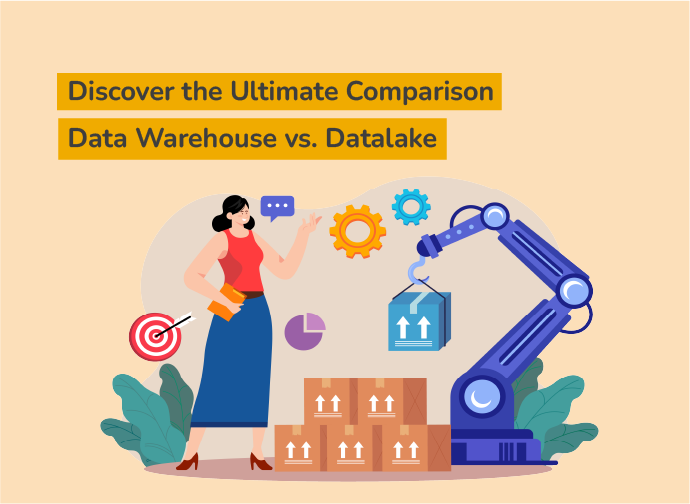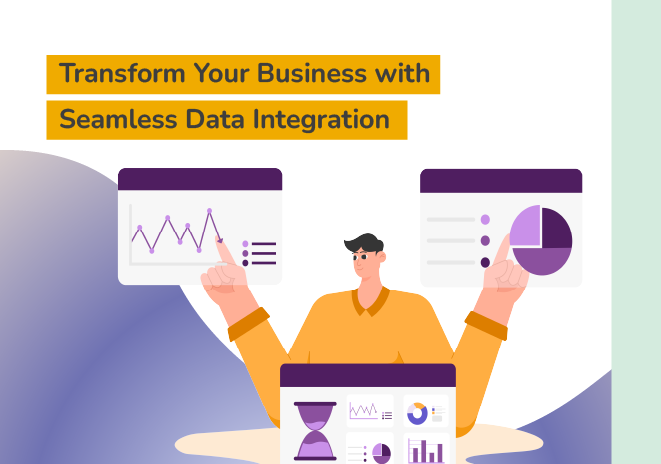What is a Data Warehouse?
A
data warehouse is a centralized repository that stores structured data from multiple sources, optimized for
reporting and
analysis. Key characteristics include integration of data via ETL processes, support for complex queries, and
history tracking. Ideal use cases involve
business intelligence, where quick insights from historical data are crucial for strategic decision-making.
Key Takeaways
- A data warehouse is optimized for storing and analyzing structured data effectively.
- Data lakes handle vast amounts of raw, unstructured data, offering high flexibility.
- Data warehouses facilitate business intelligence, enabling strategic decision-making.
- Cost considerations play a significant role in choosing between a data warehouse and a data lake.
- Integrating both data warehouses and data lakes provides a comprehensive solution for data management and analysis.
- Choosing the right data storage solution depends on the organization’s specific needs and data processing requirements.
Definition of Data Warehouse
A
data warehouse is a centralized repository designed to store
structured data from multiple sources efficiently. It is optimized for
query performance and data analysis, supporting decision-making processes. Data warehouses integrate data for advanced reporting and
business intelligence activities. They offer consistent data formats, allowing for complex queries on
historical data. Such frameworks are essential for organizations seeking informed strategic decisions.
Key Characteristics of Data Warehouses
Data
warehouses are structured storage solutions optimized for fast querying and reporting. They are designed to handle
large volumes of data and provide a
centralized repository for historical data analysis. Key characteristics include
rigid schema structure,
integrated data from various sources, and a focus on
consistency and
accuracy. These features make data warehouses ideal for
decision-support systems and detailed data analysis.
Use Cases for Data Warehouses
Data warehouses are integral for businesses requiring high-performance analytics. From
retail forecasting to
healthcare compliance, their structured data models cater to various
industries. With robust
analysis capabilities, they enable historical data aggregation for financial institutions to detect credit risks, while providing swift insights for optimal decision-making.
What is a Data Lake?
A Data Lake is a centralized repository designed to store all forms of structured, semi-structured, and unstructured data at any scale. Unlike traditional data storage solutions, data lakes maintain raw data, enabling future processing. This flexibility supports analytics, machine learning, and real-time data processing, accommodating diverse use cases and fostering innovation in data-intensive fields.
| Feature |
Details |
| Data Structure |
Supports structured & unstructured |
| Flexibility |
High |
| Scalability |
Excellent |
Definition of Data Lake
A
data lake is a centralized repository designed to store large volumes of raw data in its native format. Unlike traditional databases, data lakes accommodate structured, semi-structured, and unstructured data. This flexibility enables businesses to perform advanced
data analytics and gain insights from diverse datasets. Being highly scalable and cost-effective, data lakes support
machine learning, real-time analytics, and extensive data exploration.
Key Characteristics of Data Lakes
Data Lakes are designed to store massive quantities of raw, unstructured data. They offer unmatched
scalability, allowing enterprises to keep
historical data without worrying about storage limits. This flexibility supports advanced analytics, enabling
real-time insights and fostering
innovation. Data Lakes excel in handling diverse data types, accommodating rapidly changing data sources and facilitating seamless integration with
Big Data tools.
Use Cases for Data Lakes
Data lakes are ideal for industries that require flexible
data storage and
processing capabilities. They’re suitable for handling
large volumes of raw, unstructured data like IoT sensor information,
social media feeds, and
clickstream data. This flexibility enables businesses in tech, healthcare, and e-commerce to leverage
big data analytics and drive
innovative solutions from complex data sets.
How do Data Warehouses and Data Lakes Differ?
Data warehouses and
data lakes serve different purposes in a data management strategy. While data warehouses excel in handling
structured data for
business intelligence, data lakes are designed for managing diverse,
unstructured data types. Their core differences lie in storage technologies, data management, and processing methods, alongside distinct
cost considerations.
Storage Technologies Differences
Data
warehouses and
data lakes employ distinct storage technologies to manage diverse data requirements. Data warehouses focus on structured datasets using OLAP systems designed for complex querying and analysis. Conversely, data lakes embrace raw, unstructured data, leveraging cost-effective storage solutions like Hadoop. Understanding these differences helps businesses align their infrastructure with
data strategy goals.
Data Management and Processing
Data management and
processing are integral to understanding the differences in
functionality between data warehouses and data lakes. While data warehouses specialize in handling structured data and providing quick retrieval for business analytics, data lakes offer versatility by storing diverse datasets, from structured to unstructured. The choice between the two largely depends on specific processing needs.
Cost Considerations
Understanding the cost considerations between
data warehouses and
data lakes is vital for effective budgeting. Data warehouses often involve higher costs due to their sophisticated architecture and optimized query performance, while data lakes present a more cost-effective option by storing large volumes of raw
data at a lower expense but might necessitate additional processing costs.
- Data Warehouses: Higher costs, optimized performance
- Data Lakes: Cost-effective, additional processing costs
What are the Pros and Cons of Data Warehouses?
Data warehouses are a cornerstone of modern analytics, offering structured data storage, enhanced performance, and tailored reporting capabilities. Among the key advantages are their ability to handle complex queries and ensure data integrity. However, they have limitations, including high costs and limited flexibility compared to newer technologies, which can hinder unstructured data processing.
Advantages of Using Data Warehouses
Data warehouses offer numerous
advantages that make them essential for businesses. They provide
structured and
centralized data storage, facilitating quick and efficient data
retrieval. Their ability to handle
complex queries enhances decision-making processes. Data warehouses support
data consistency and accuracy, making them
reliable for business intelligence activities. The secure and
scalable architecture further aids organizations in maintaining comprehensive
historical data analyses.
Limitations of Data Warehouses
Data Warehouses excel in structured data storage and analytics, but they come with
limitations such as high
cost and rigid data
schema requirements. The
complexity of managing large-scale transactional data and slower
scaling capabilities can hinder rapid
adaptation to changing business needs. Moreover, the necessity for extensive
ETL processes increases
time and
resource demands.
What are the Pros and Cons of Data Lakes?
Data lakes offer unmatched flexibility, handling
large volumes of unstructured data effortlessly. Their ability to store data in its native format is a key advantage, making them ideal for
real-time analytics. However, they pose challenges like data governance and security issues. Deciding to use a data lake involves weighing these
advantages and
limitations.
Advantages of Using Data Lakes
Data
lakes offer unparalleled flexibility and are ideal for storing raw data from multiple sources. They enable organizations to perform extensive data analytics, which supports advanced machine learning and artificial intelligence. The scalability and cost-effectiveness of data lakes make them a preferred choice for handling large volumes of
unstructured data, providing significant insights for data-driven decision-making.
Limitations of Data Lakes
Data lakes offer flexibility with unstructured data, but they come with certain limitations. The lack of predefined schemas can lead to data swamps if not managed properly. This complexity requires robust governance and security measures to ensure data integrity. Additionally, the analytical processing may be slower without proper indexing, impacting real-time analysis capabilities.
| Limitation |
Description |
| Data Swamps |
Unmanaged and unstructured data |
| Security Challenges |
Requires robust governance and security |
| Slower Analysis |
Lack of indexing affects real-time use |
When Should You Use a Data Warehouse Over a Data Lake?
Choosing between a data warehouse and a data lake hinges on specific business needs and use cases. Opt for a data warehouse when dealing with structured data requiring consistent reporting and analysis. Industries like finance and healthcare often rely on the robust features of a data warehouse for compliance and efficiency.
Ideal Scenarios for Data Warehouse Implementation
Data warehouses are optimal for structured data environments where precise, organized information is crucial. Ideal scenarios involve environments needing historical data analysis, business intelligence, and compliance with regulatory data requirements. Industries like finance, healthcare, and retail often implement data warehouses for reporting and trend analysis, thriving on reliable data consistency.
Industry Use Cases
Industry
use cases for
data warehouses often involve transactional data, reflecting their strength in structured environments such as finance, retail, and operations. In contrast,
data lakes excel in
big data applications like IoT, unstructured data collection, and analytics, supporting industries like healthcare, technology, and research. Choosing the right solution depends on specific organizational needs and data processing requirements.
When Should You Use a Data Lake Over a Data Warehouse?
Opting for a data lake over a data warehouse is ideal when handling raw, unstructured data that requires scalability and flexibility. Industries such as media and entertainment often benefit, as data lakes efficiently manage large volumes of varied data types, supporting advanced analytics and machine learning applications.
Ideal Scenarios for Data Lake Implementation
Data lakes are ideal for
scenarios where organizations require
scalable storage to handle vast amounts of raw and unstructured data without predefined schemas. They enable real-time analytics,
machine learning, and support diverse
data types. Industries like
healthcare and
finance benefit from data lakes due to the need for complex
data processing and dynamic insights.
Industry Use Cases
Data warehouses and data lakes serve different purposes in various industries. While data warehouses excel in analytics and reporting for sectors like finance and healthcare, offering structured and reliable insights, data lakes are invaluable for big data analytics in industries such as IoT and social media, facilitating deep, unstructured data analysis. Choosing the right solution depends on the specific needs and objectives of the industry.
Can Data Warehouses and Data Lakes Be Used Together?
Integrating data warehouses and data lakes offers a powerful hybrid solution, enhancing data management strategies by leveraging the strengths of both. While data warehouses excel in structured data processing, data lakes provide supreme flexibility for unstructured data. Combining these systems can streamline analytics, improving decision-making efficiency and fostering innovative insights within organizations.
Benefits of Integrating Data Warehouses and Data Lakes
Integrating data warehouses and data lakes offers unparalleled advantages, combining structured data management with flexible, scalable storage solutions. This powerful synergy enhances data accessibility, facilitates complex analyses, and optimizes business intelligence. By leveraging both systems, organizations gain deeper insights and accelerate decision-making, ultimately driving competitive advantage in a data-driven market.
„Integrating data warehouses and data lakes can provide a comprehensive solution, offering structured processing and scalable storage, leading to efficient data management.“
Examples of Hybrid Solutions
Integrating a
data warehouse and a
data lake can lead to enhanced
data management and
analytics capabilities. These
hybrid solutions enable organizations to leverage structured and unstructured data effectively. By combining the strengths of both, companies gain flexibility in data storage, access, and processing. Various industries have successfully implemented hybrid models to optimize their data strategies for real-time analytics and long-term storage needs.
Which is Better: Data Warehouse or Data Lake?
Choosing between a data warehouse and a data lake depends largely on your business needs and objectives. Data warehouses offer structured data storage, valuable for businesses requiring complex analytics and reporting. In contrast, data lakes excel in handling large volumes of unstructured data, ideal for organizations focusing on big data analytics and real-time insights. Both have unique strengths and utilize distinct technologies.
Factors to Consider in Decision-Making
When choosing between a data warehouse and a data lake, several factors need careful consideration. Evaluate your business objectives, such as the nature of data, scalability needs, and budget constraints. The differences in data processing capabilities and storage technology should also be weighed to determine the most suitable solution for your organization.
Business Needs and Objectives
Selecting between a data warehouse and a data lake hinges on understanding business needs and objectives. A data warehouse excels with structured data, offering insights for decision-making. Conversely, a data lake is versatile, accommodating both structured and unstructured data, ideal for big data analytics. Align your choice with your company’s data strategy and analytical demands to achieve the best results.
What is the Future of Data Warehouses and Data Lakes?
In the evolving landscape of data management, understanding the future of both data warehouses and data lakes is crucial for businesses anticipating emerging trends. With advancing technologies, these platforms are expected to innovate, driven by new data storage solutions. Predictive analytics and AI integration are set to redefine how organizations leverage their data assets.
Emerging Trends in Data Management
As data management evolves, organizations are adopting innovative approaches to store and analyze information. Key
emerging trends include the integration of artificial intelligence to facilitate automated data processing, and the shift towards serverless architecture for scalable, efficient solutions. Furthermore, businesses are increasingly leveraging multi-cloud strategies to enhance flexibility and resilience in their data operations.
Predictions and Innovations in Data Storage
The future of data storage is set to be revolutionized by emerging technologies and trends. With innovations focusing on scalability, integration, and real-time processing, businesses can anticipate significant advances in how they manage and analyze data. Embracing these changes will be crucial for competitive advantage in an increasingly data-driven world.
FAQ
What is a data warehouse?
A data warehouse is a centralized repository that stores structured data from multiple sources, optimized for reporting and analysis.
What are the key characteristics of a data warehouse?
Key characteristics of a data warehouse include the integration of data, support for complex queries, history tracking, and being ideal for business intelligence.
What is a data lake?
A data lake is a centralized repository designed to store all forms of structured, semi-structured, and unstructured data at any scale, allowing for future processing.
What differentiates data warehouses from data lakes?
Data warehouses excel in handling structured data for business intelligence, while data lakes manage diverse, unstructured data types.
What are the advantages of using data lakes?
Data lakes offer unparalleled flexibility and are ideal for storing raw data, supporting advanced analytics and machine learning.
What limitations do data lakes face?
Data lakes may lead to data swamps without proper management and face challenges in governance and security.
When should you use a data warehouse over a data lake?
Opt for a data warehouse when dealing with structured data that requires consistent reporting and analysis, essential for industries such as finance and healthcare.
What are the benefits of integrating data warehouses with data lakes?
Integrating data warehouses and data lakes enhances data management by combining structured processing with scalable storage, leading to efficient data manipulation.
What are some emerging trends in data management?
Emerging trends in data management include integrating artificial intelligence, moving towards serverless architecture, and adopting multi-cloud strategies for enhanced flexibility.









